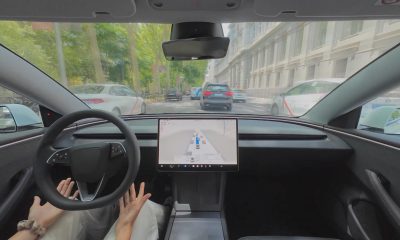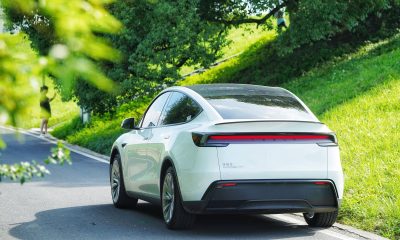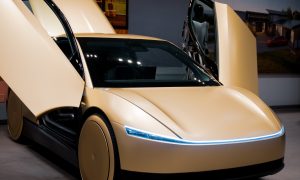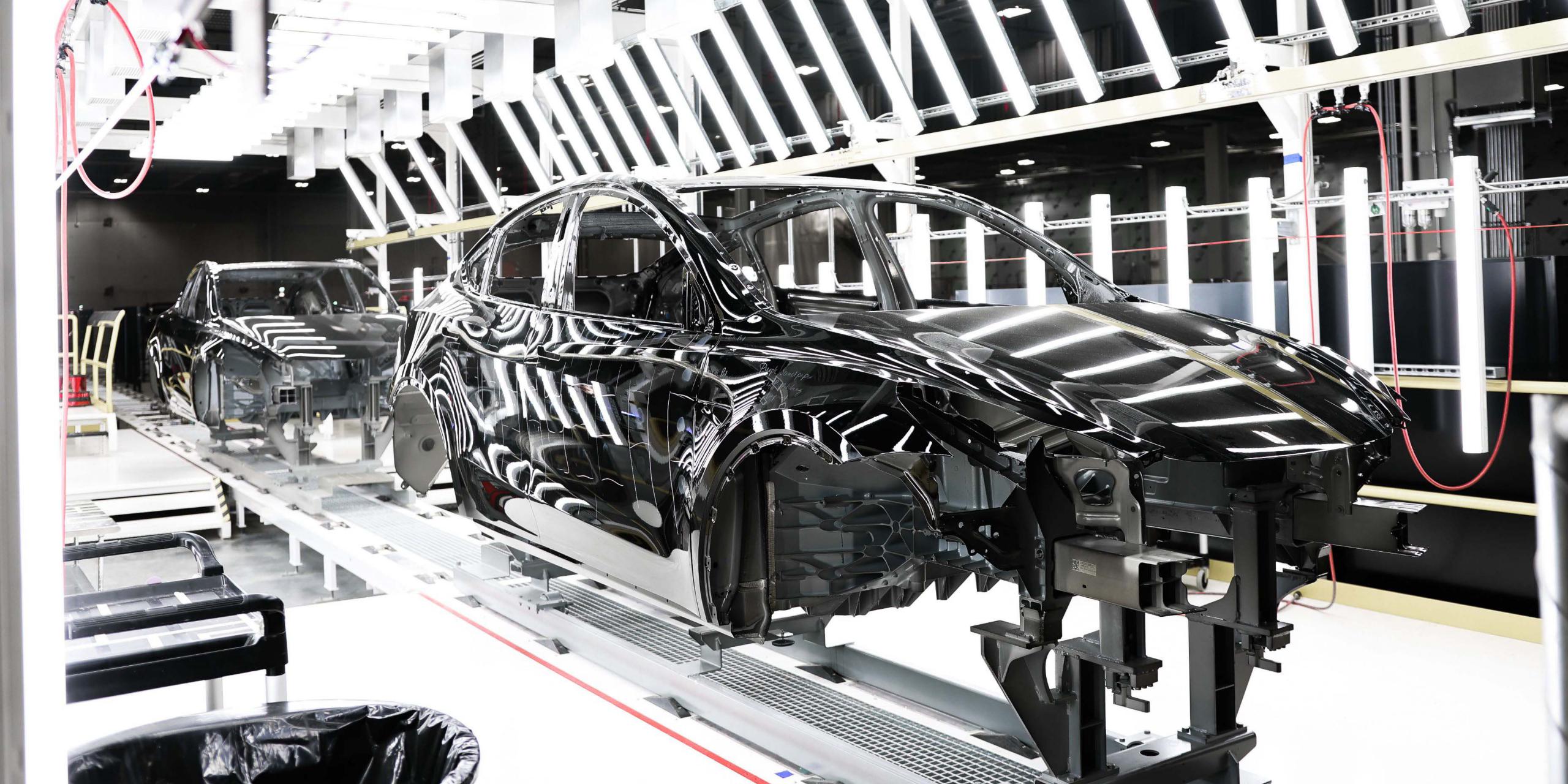

News
Tesla Model Y from Giga Texas is just one EPA approval away from first deliveries
Hundreds of Tesla Model Y all-electric crossovers have been spotted in the lots of Gigafactory Texas in the past few weeks, with some being spotted on haulers to be driven to destinations not known. However, haulers will likely be back soon for another logistics mission: to pick up the “Austin-made” Model Ys and take them to customers for delivery.
Tesla will be able to begin delivering units of its Austin-made Model Y all-electric crossover from Gigafactory Texas following the EPA approval of the vehicle, the agency told Teslarati. Currently, the Model Y from Gigafactory Texas is being produced with Tesla’s newest 4680 battery cells and new structural battery pack, has not gained its Certificate of Conformity, a document needed for a vehicle to be introduced into commerce.
Certificates of Conformity are effectively approval by the EPA that a vehicle can enter the stream of commerce. If it is introduced into commerce, the vehicle must have a Certificate of Conformity. The certifications are valid for a single model year, and new model year vehicles make their way to the EPA’s testing facility in Ann Arbor, Michigan every year to confirm they align with the EPA’s emissions standards.
“Prior to offering a vehicle for sale, all carlines in the Light-duty sector must be certified and Fuel Economy test data representing each model type must be submitted to EPA,” the EPA said to Teslarati in a statement. “EPA can confirm that Tesla has received a Certificate of Conformity for the 2022 Model Y Long Range AWD, Model Y Performance AWD (Test Group NTSLV00.0L2Y) and a Certificate for the Model Y RWD (Test Group NTSLV00.0L1Y).” These test groups were certified by the EPA last year, with the 2022 Model Y Long Range AWD and Performance variants gaining their Certificate of Conformity on November 1, 2021. It does not expire until December 31, 2022. The 2022 Model Y RWD, which is the variant that Tesla ultimately did not sell, gained its Certificate of Conformity from the EPA on September 28.
(Credit: Jeff Roberts)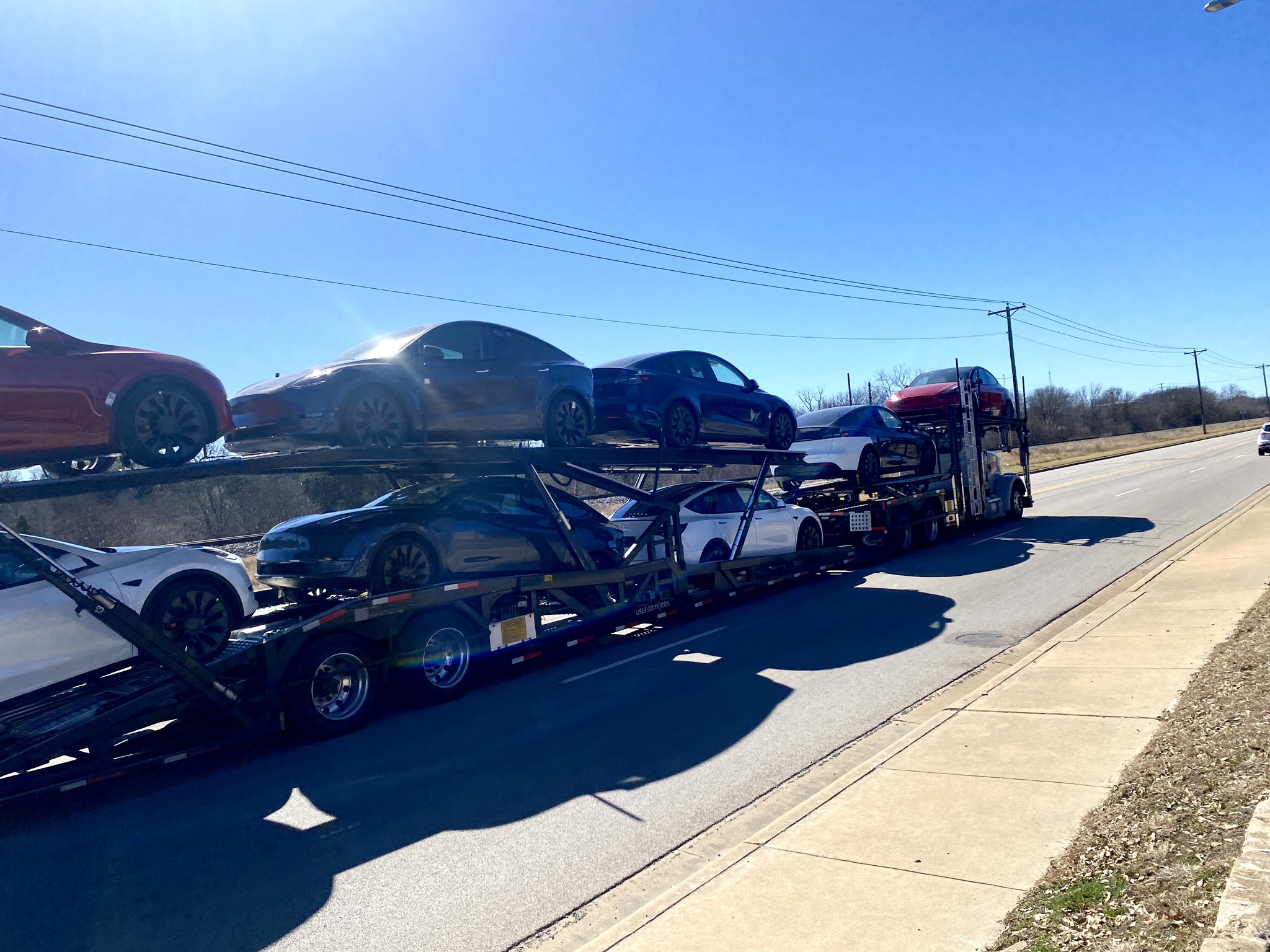
Tesla’s Model Y made in Austin will also be a 2022 Model Y, which would mean it would technically align with the EPA’s Certificates of Conformity, especially as the geographic location of manufacture does not determine whether a vehicle conforms to the EPA’s standards or not. “EPA does not use the build location as a descriptor for a new test group or Certificate of Conformity,” the agency said. Instead, updates in the vehicle’s battery pack can prompt the EPA to consider certifying a vehicle again, even if the changes occur to a car in the same model year. However, the changes made to the vehicle prompted the EPA to certify the Austin-made Model Y separately.
In its 2017 document titled, “EPA Test Procedures for Electric Vehicles and Plug-in Hybrids,” the agency says that Confirmatory Testing for vehicles with the same model year is determined on a case-by-case basis, and the EPA can make a choice to certify a vehicle based on the changes:
“Currently, EPA performs confirmatory testing on all new light-duty electric vehicles and plug-in hybrid vehicles at EPA’s emission testing laboratory in Ann Arbor Michigan. If the manufacturer makes changes to an EV or PHEV that was previously tested at EPA, EPA will decide on a case-by-case basis whether additional EPA confirmatory testing is needed.”
What were the changes Tesla made exactly? The EPA confirmed to us that it could not comment on the status “of preproduction vehicles that are pending new emissions certification until manufacturers introduce them into commerce,” which means the Model Y’s changes are confidential until the car earns its Certificate of Conformity. Tesla did not respond to our inquiries to clarify why the vehicle needed to go through the EPA’s conformity procedure once again. However, Tesla’s most recent Earnings Call provided plenty of color to what the changes that prompted a new certification process likely are, and it has to do with Tesla’s 4680 battery cell.
The Battery Pack likely required the EPA to certify the Model Y once again
During the Q4 2021 Earnings Call, Tesla said that “after final certification of Austin-made Model Y, we plan to start deliveries to customers.” Additionally, during the Earnings Call CEO Elon Musk stated that Tesla was “building the Model Ys with the structural battery pack and the 4680 cells, and we’ll start delivering after final certification of the vehicle, which should be fairly soon.” Read More.
Previous builds of the Model Y, even 2022 model year vehicles, which were built at the Fremont Factory, have not yet used Tesla’s 4680 battery pack or the structural battery pack. Instead, Model Ys built at Fremont in the United States have used the automaker’s previous cell chemistry, the 2170 cell. When the EPA certified Tesla’s 2022 model year vehicles in August 2021, the certifications were for the previous battery pack. Read More.
Tesla Model Y from Giga Texas will equip Structural Battery Pack, 4680 cells
The 4680 batteries differ significantly from the 2170 cell in power, range, and efficiency. Therefore, the Model Y from Texas will have ratings that are substantially different from previous builds from Fremont. The Model Y from Austin needs eMPG ratings for FuelEconomy.gov and Monroney stickers.
Once Tesla is granted a Certificate of Conformity for Model Ys that are set to be produced at Gigafactory Texas, the automaker will be able to deliver the vehicles to customers.
Documents obtained by Teslarati show Tesla’s application to have the Model Y’s AWD and Performance variants certified together, while the RWD build of the car was certified separately. The documents state that each variant of the car conformed with California Air and Resource Board (CARB) standards, as well as Federal Emissions Standards that States which do not align with the CARB standards utilize. Texas withdrew its intentions to adopt CARB standards in 2007, State documents revealed.
States that have adopted CARB standards are New York, Massachusetts, Vermont, Maine, Pennsylvania, Connecticut, Rhode Island, Washington, Oregon, New Jersey, Maryland, Delaware, and most recently, Colorado, which adopted the standards this year.
How long until the Tesla Model Y from Gigafactory Texas is approved by the EPA?
The EPA cannot predict the timing of the certification process, and it varies from vehicle to vehicle. Rough timeframes are available by determining when Tesla submitted an application for a vehicle and when the vehicle gained its Certificate of Conformity.
Tesla’s application for the 2022 Model Y Long Range AWD and Performance variants is dated for October 21, while the Certificate of Conformity is dated November 1. However, this vehicle had a previous model year and utilized the same battery pack. The timeframe may be quicker as the 4680 pack has not been previously tested by the EPA for a passenger vehicle.
When Tesla submitted its application for the 2021 Model Y, it was the first certification process for the vehicle. Tesla submitted the application on December 13, 2019, with the Model Y gaining its Certificate of Conformity about a month later on January 8.
If Tesla submitted its application for the new Model Y on January 26 when it announced it was awaiting certification, deliveries could be approved within the coming days.
4680 Battery Cell
In September 2020, Tesla held “Battery Day” to unveil a new cell and manufacturing design that would increase vehicle safety and structural integrity. Musk unveiled the 4680 cell, a new electric vehicle battery capable of more range, power, and performance while offering a longer life cycle. Tesla has been producing the cell in volume at a facility known as Kato Road near the company’s Fremont factory in Northern California. Until now, no customer has driven a Tesla vehicle equipping the 4680 cell. The Model Y built at the Texas factory will be the first Tesla vehicle to utilize the new 4680 battery pack. Read More.
The vehicle will also utilize Tesla’s structural battery pack, the automaker confirmed. The structural battery pack uses engineering similar to an aircraft wing to use negative mass to increase structural integrity and density. The packs will also use a structural adhesive and flame retardant, attaching cells to the floor and ceiling of the pack, increasing stiffness and preventing major deformation in the event of a crash. Read More.
I’d love to hear from you! If you have any comments, concerns, or questions, please email me at joey@teslarati.com. You can also reach me on Twitter @KlenderJoey, or if you have news tips, you can email us at tips@teslarati.com.
Elon Musk
Why Tesla’s Q3 could be one of its biggest quarters in history
Tesla could stand to benefit from the removal of the $7,500 EV tax credit at the end of Q3.

Tesla has gotten off to a slow start in 2025, as the first half of the year has not been one to remember from a delivery perspective.
However, Q3 could end up being one of the best the company has had in history, with the United States potentially being a major contributor to what might reverse a slow start to the year.
Earlier today, the United States’ House of Representatives officially passed President Trump’s “Big Beautiful Bill,” after it made its way through the Senate earlier this week. The bill will head to President Trump, as he looks to sign it before his July 4 deadline.
The Bill will effectively bring closure to the $7,500 EV tax credit, which will end on September 30, 2025. This means, over the next three months in the United States, those who are looking to buy an EV will have their last chance to take advantage of the credit. EVs will then be, for most people, $7,500 more expensive, in essence.
The tax credit is available to any single filer who makes under $150,000 per year, $225,000 a year to a head of household, and $300,000 to couples filing jointly.
Ending the tax credit was expected with the Trump administration, as his policies have leaned significantly toward reliance on fossil fuels, ending what he calls an “EV mandate.” He has used this phrase several times in disagreements with Tesla CEO Elon Musk.
Nevertheless, those who have been on the fence about buying a Tesla, or any EV, for that matter, will have some decisions to make in the next three months. While all companies will stand to benefit from this time crunch, Tesla could be the true winner because of its sheer volume.
If things are done correctly, meaning if Tesla can also offer incentives like 0% APR, special pricing on leasing or financing, or other advantages (like free Red, White, and Blue for a short period of time in celebration of Independence Day), it could see some real volume in sales this quarter.
You can now buy a Tesla in Red, White, and Blue for free until July 14 https://t.co/iAwhaRFOH0
— TESLARATI (@Teslarati) July 3, 2025
Tesla is just a shade under 721,000 deliveries for the year, so it’s on pace for roughly 1.4 million for 2025. This would be a decrease from the 1.8 million cars it delivered in each of the last two years. Traditionally, the second half of the year has produced Tesla’s strongest quarters. Its top three quarters in terms of deliveries are Q4 2024 with 495,570 vehicles, Q4 2023 with 484,507 vehicles, and Q3 2024 with 462,890 vehicles.
Elon Musk
Tesla Full Self-Driving testing continues European expansion: here’s where
Tesla has launched Full Self-Driving testing in a fifth European country ahead of its launch.

Tesla Full Self-Driving is being tested in several countries across Europe as the company prepares to launch its driver assistance suite on the continent.
The company is still working through the regulatory hurdles with the European Union. They are plentiful and difficult to navigate, but Tesla is still making progress as its testing of FSD continues to expand.
Today, it officially began testing in a new country, as more regions open their doors to Tesla. Many owners and potential customers in Europe are awaiting its launch.
On Thursday, Tesla officially confirmed that Full Self-Driving testing is underway in Spain, as the company shared an extensive video of a trip through the streets of Madrid:
Como pez en el agua …
FSD Supervised testing in Madrid, Spain
Pending regulatory approval pic.twitter.com/txTgoWseuA
— Tesla Europe & Middle East (@teslaeurope) July 3, 2025
The launch of Full Self-Driving testing in Spain marks the fifth country in which Tesla has started assessing the suite’s performance in the European market.
Across the past several months, Tesla has been expanding the scope of countries where Full Self-Driving is being tested. It has already made it to Italy, France, the Netherlands, and Germany previously.
Tesla has already filed applications to have Full Self-Driving (Supervised) launched across the European Union, but CEO Elon Musk has indicated that this particular step has been the delay in the official launch of the suite thus far.
In mid-June, Musk revealed the frustrations Tesla has felt during its efforts to launch its Full Self-Driving (Supervised) suite in Europe, stating that the holdup can be attributed to authorities in various countries, as well as the EU as a whole:
Tesla Full Self-Driving’s European launch frustrations revealed by Elon Musk
“Waiting for Dutch authorities and then the EU to approve. Very frustrating and hurts the safety of people in Europe, as driving with advanced Autopilot on results in four times fewer injuries! Please ask your governing authorities to accelerate making Tesla safer in Europe.”
Waiting for Dutch authorities and then the EU to approve.
Very frustrating and hurts the safety of people in Europe, as driving with advanced Autopilot on results in four times fewer injuries!
Please ask your governing authorities to accelerate making Tesla safer in Europe. https://t.co/QIYCXhhaQp
— Elon Musk (@elonmusk) June 11, 2025
Tesla said last year that it planned to launch Full Self-Driving in Europe in 2025.
Elon Musk
xAI’s Memphis data center receives air permit despite community criticism
xAI welcomed the development in a post on its official xAI Memphis account on X.

Elon Musk’s artificial intelligence startup xAI has secured an air permit from Memphis health officials for its data center project, despite critics’ opposition and pending legal action. The Shelby County Health Department approved the permit this week, allowing xAI to operate 15 mobile gas turbines at its facility.
Air permit granted
The air permit comes after months of protests from Memphis residents and environmental justice advocates, who alleged that xAI violated the Clean Air Act by operating gas turbines without prior approval, as per a report from WIRED.
The Southern Environmental Law Center (SELC) and the NAACP has claimed that xAI installed dozens of gas turbines at its new data campus without acquiring the mandatory Prevention of Significant Deterioration (PSD) permit required for large-scale emission sources.
Local officials previously stated the turbines were considered “temporary” and thus not subject to stricter permitting. xAI applied for an air permit in January 2025, and in June, Memphis Mayor Paul Young acknowledged that the company was operating 21 turbines. SELC, however, has claimed that aerial footage shows the number may be as high as 35.
Critics are not giving up
Civil rights groups have stated that they intend to move forward with legal action. “xAI’s decision to install and operate dozens of polluting gas turbines without any permits or public oversight is a clear violation of the Clean Air Act,” said Patrick Anderson, senior attorney at SELC.
“Over the last year, these turbines have pumped out pollution that threatens the health of Memphis families. This notice paves the way for a lawsuit that can hold xAI accountable for its unlawful refusal to get permits for its gas turbines,” he added.
Sharon Wilson, a certified optical gas imaging thermographer, also described the emissions cloud in Memphis as notable. “I expected to see the typical power plant type of pollution that I see. What I saw was way worse than what I expected,” she said.
-

 Elon Musk3 days ago
Elon Musk3 days agoTesla investors will be shocked by Jim Cramer’s latest assessment
-

 News1 week ago
News1 week agoTesla Robotaxi’s biggest challenge seems to be this one thing
-

 News2 weeks ago
News2 weeks agoTexas lawmakers urge Tesla to delay Austin robotaxi launch to September
-

 Elon Musk2 weeks ago
Elon Musk2 weeks agoFirst Look at Tesla’s Robotaxi App: features, design, and more
-

 Elon Musk2 weeks ago
Elon Musk2 weeks agoxAI’s Grok 3 partners with Oracle Cloud for corporate AI innovation
-

 News2 weeks ago
News2 weeks agoWatch Tesla’s first driverless public Robotaxi rides in Texas
-

 News2 weeks ago
News2 weeks agoSpaceX and Elon Musk share insights on Starship Ship 36’s RUD
-

 News2 weeks ago
News2 weeks agoTesla has started rolling out initial round of Robotaxi invites




